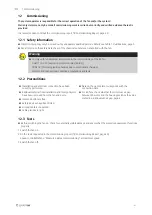
2
| Important safety information
Warning
Regarding the choice of material, the EX fans fulfil the requirements of Standard DIN 14986 (Construction of
fans for use in potentially explosive atmospheres) as a result of specific protection measures in areas of
potential contact between rotating and stationary components (rotor/intake nozzle).
A safety clearance to the intake nozzle is guaranteed for the rotating part. The plant builder is responsible
for selecting the materials for the fixed peripheral parts for fan designs without protective grids. Only pairs
of materials according to Standard DIN EN 14986 are to be used.
Warning
The temperature class stated on the EX name plate (motor) must match the temperature class of the
combustible gas which may occur, or the motor must have a higher temperature class.
Danger
Explosion protection
Transport damage or failure to comply with this information can lead to loss of explosion protection.
♦
In the event of recognisable transport damage, contact the manufacturer and do not put the device into
operation.
Warning
The effects of lightning strikes must be limited so that hazards are prevented. In addition to protection
against the effects of "direct" lightning strikes, this also includes protection against lightning strikes at a
distance from the building. The latter can lead to hazards resulting from excess voltage.
♦
Carry out a risk analysis according to DIN VDE 0100, part 443, with a balance between protection and
consequences, taking the probability of the occurrence of excess voltage into account.
♦
Protect all devices, protective systems and components by using suitable lightning and excess voltage
protection measures.
Warning
Ignition protection class „d“
If fans are controlled using motors with a "d" ignition protection class with a frequency converter, then
thermal protection via a PTC resistor in the motor is required.
3
Important safety information
Planners, plant builders and operators are responsible for the proper assembly and intended use.
♦
Read the operating instructions completely and carefully.
♦
Keep the operating instructions and other valid documents, such as the circuit diagram or motor instructions, with
the fan. They must always be available at the place of use.
♦
Observe and respect local conditions, regulations and laws.
♦
Abide by the system-related conditions and requirements of the system manufacturer or plant constructor.
♦
Safety elements may not be dismantled, circumvented or deactivated.
♦
Only use the fan in a flawless condition.
♦
Provide generally prescribed electrical and mechanical protective devices.
♦
During installation, electrical connection, commissioning, troubleshooting, and maintenance, secure the location and
premises against unauthorised access.
♦
Do not circumvent any safety components or put them out of action.
♦
Before any work on the fan, test absence of voltage.
Even when the motor is stopped, dangerous voltages may be present on terminals.
♦
Keep all the warning signs on the fan complete and in a legible condition.
♦
The device is not to be used by persons (including children) with reduced physical, sensory or mental capabilities, or
lack of experience and knowledge, unless they have been given supervision or instruction.
♦
Do not allow children to play with the device.
| 008
Summary of Contents for 33986
Page 4: ......







































